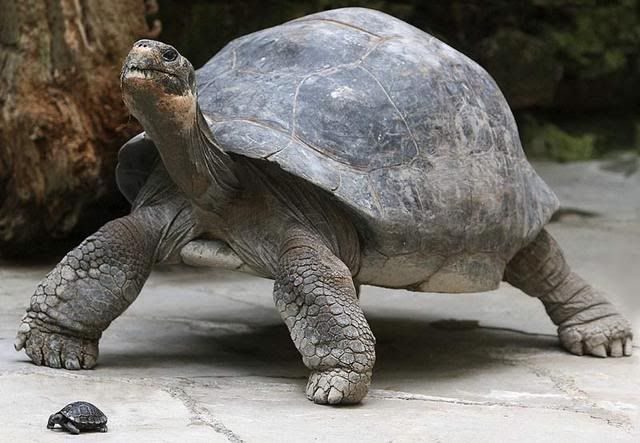 I actually don't know if you say it was 'born' or it was 'hatched'. Either way, there's a new baby Galapagos Giant Tortoise at the Zürich Zoo.
I actually don't know if you say it was 'born' or it was 'hatched'. Either way, there's a new baby Galapagos Giant Tortoise at the Zürich Zoo.
The picture above gives you some idea of the size difference between the mama tortoise and the baby tortoise who was either born or hatched a few weeks ago. The 70-year-old Nigrita who weighs about 550 pounds has lived in the Zürich Zoo since 1946. She gave birth to her little one who weights 2.8oz but will eventually get as large as she is.
Seventy may seem rather old to be reproducing, but the Galapagos tortoise doesn't reach sexual maturity until it is 25, and can live to be more than 150 years old.
Mating can occur at any time during the year, and the female tortoise can produce between two and 16 tennis ball-sized eggs, which she buries in a 1ft deep nest.
They then incubate for around 130 days. Unusually, temperature can effect the gender of the hatchlings — a low nest temperature means they are likely to be male, while a hot, stuffy nest is more likely to produce females.
However, it is impossible to determine the sex of a Galapagos tortoise until it is 15 years old.
A fully-grown tortoise such as Nigrita can weigh up to 550lb and measure more than 3ft high. In contrast, her young weighs only 2.8oz and measures just 2.4in.
Growth will occur slowly over the next 40 years, at which point the tortoises reach full size. Their large shells add to their impressive appearance and act as a shield against predators.
This magnificent armour is actually a bone, and a crucial part of the tortoise skeleton. However, it does slow them down, as they have an average speed of only 0.18mph.
No one knows why the Galapagos reptiles are so large, but it's possible that a lack of predators on the South American islands meant they evolved free from danger — until they were discovered by mankind in the 18th century.
During the 18th and 19th centuries, many of the tortoises were killed for food by whalers and pirates. When they were discovered, there were around 250,000 on the islands.
Today there are 15,000, and although they are protected by law, poaching continues — 120 have been killed since 1990.
Now you can't say you don't learn something by coming to Blue Star Chronicles!
source


|